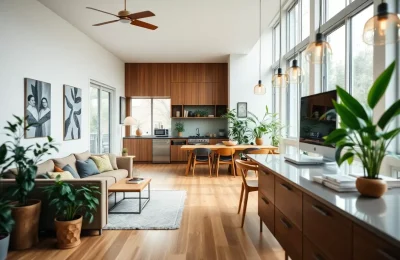
One of the latest trend in home interior design is the open concept , that natural light can reach all areas of the house. It is good for families with small children, because you can watch them throughout the house.
But as there are no walls to separate the rooms, the noise pollution may be a problem. Here is some information on the positive and negative sides of the house with an open layout:
More Space
Wide-open ideas leave no space unused, effectively getting the most out of your home by getting rid of the wasted space taken up by hallways and walls. Maximum space means maximum benefit.
Improve Traffic Flow
Without walls, moving between rooms is uninterrupted and easy, which is a luxury if you live with children, or even if you (or someone you love) is physically challenged. It’s not just a quality for homes with children – moving between rooms, for those who live alone, can be even more unbroken and easy.
Increase Visibility
There are no walls being placed between you and your kids, which makes it easier to see the little ones from the kitchen or from your work space – that is very convenient for families who want to know where are their children at all times.
In the home, natural light can trickle further into the house thanks to greater opportunities for it to enter through fewer walls; at the same time, greater illumination can lower energy usage for those energy-conscious home owners, and might also have secondary health benefits.
Better Traffic Flow
An ‘open concept floor plan’ does away with interior walls, encouraging the kitchen, dining area and living room to flow into one large space. In doing so, homeowners can easily circulate between these rooms – handy for families that like to cook together! They allow users unobstructed sightlines, thanks to the removal of walls as additive features; likewise, the large windows that often accompany open-concept layouts, and the outdoor landscapes that they frame, add to the liveliness of such panoramic perspectives by opening them up to the exterior world. Open-concept layouts allow users unobstructed sightlines, thanks to the removal of walls as additive features At the same time, open-concept layouts consist of demarcated living areas that have been blended together, thereby rendering them less self-contained. One of my design rules for open-concept homes is to be mindful of travel paths. Make sure there’s enough room for people to move through the space without having to maneuver around furniture. Use rugs as a way to designate more intimate zones; this helps to keep furniture and other clutter to a minimum, while providing a more organised home environment.
More Comfort
The open floor plan enables an expansive viewing angle of the entire house by removing the walls, pillars and partitions that prevent the line of sight, particularly for households with young children; parents can have a view of their children as they cook and do other chores. In traditional floorplans, walls provide clear boundaries that help to segregate family members who want to sit in quiet and not hear anything from those who want to move about and make noise. It’s much easier to keep quiet spaces clean and clutter-free. But in an open floorplan, it is more difficult to do this. Another advantage of the open concept house design is the cost efficiency of heating and cooling costs. Walls, in a traditional sense, restrict heat flow to specific rooms, making the overall home more expensive to keep at a constant temperature. Open layouts without the use of partition walls can also become noisier, as sound can travel from room to room with less restrictions and barriers between each space.
More Privacy
The open-concept home design has long been seen as bringing families closer together, but in the midst of more families working from home and parents struggling to get Zoom meetings done with their kids nearby, some are reconsidering it because of the lack of sound control and privacy. Open-concept layouts are desirable for all these reasons – not only do they give your home depth and more usable space, they also allow light to pass more freely through the combination of large windows and sliding doors that directly open to outdoor living areas that feel like a natural extension of your interior. By having an open-concept design, you will be providing more natural light to every part of your house and will help you with relaxing by getting light everywhere. A traditional layout could have the tendency to act as barriers to its warming effect; with an open concept plan, the natural light will be free to go everywhere making every part of the house due to the light everywhere.
More Entertaining
The open layout gives homeowners more room to entertain without sacrificing functionality, and makes it easier to get around the house without doors and hallways for those who live with disabilities. Line of sight between living areas is maintained, allowing you to easily keep an eye on kids watching TV in the family room or sneaking snacks from the kitchen when you’re cooking – a benefit that’s particularly helpful if you have small kids or pets. Furniture configurations, area rugs and lighting fixtures can help delineate each zone of your open space. A complementary colour scheme with accents that recur helps, too – choose a palette that remains the same across the room, and make an open space welcoming with natural accents, such as reclaimed wood accents or stone countertops.










